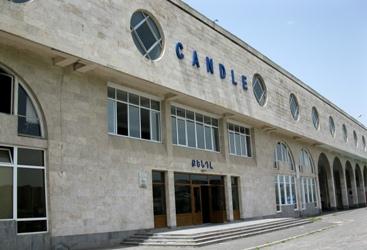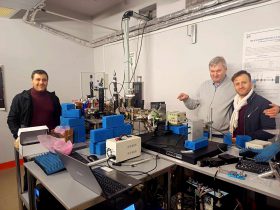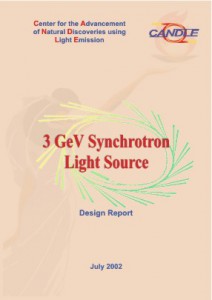WELCOME
We are pleased to announce to the Scientific Community around the world of the establishment of CANDLE (Center for the Advancement of Natural Discoveries using Light Emission) and of its plans to construct a 3 GeV Third Generation Synchrotron Light Source Facility in the Republic of Armenia. CANDLE is a private non-profit corporation headquartered in the United States of America with a subsidiary in Armenia
It is our vision and desire that CANDLE will provide an opportunity for the scientists in the region and beyond to have access to a user-friendly, world-class, third generation light source. A natural byproduct of CANDLE will be the renewal of the scientific standards in Armenia to its past world-class level, and the provision of employment for Armenian, as well as, neighboring mature and young scientists, thus reversing the brain drain from the region. These scientists will conduct research and development to bring about advances in health, environmental protection, physics, chemistry, biology, geology, electronics, crystallography and other useful and peaceful causes for the benefit of all humanity. As its initial activity, a large group of scientists from Armenia, with the help of many scientists from the international community have prepared this CANDLE Design Report, which will be reviewed and become the basis for proceeding to construction. Upon conclusion of the review and a favorable recommendation, construction will begin with an estimated 5-year completion date. While many of the activities are to be done in Armenia, we anticipate strong scientific collaborations between Armenia and neighboring and far countries for the design, construction and operation of CANDLE. We welcome any suggestions or recommendations from qualified individuals, scientists, engineers, machinists and philanthropists.
President, Jirair Hovnanian
Author List & Acknowledgements
2. Overview
2.1 Scientific Case
2.2 Synchrotron Radiation characteristics
2.3 Design Overview
3. Storage Ring
3.1 Magnetic Lattice
3.1.1 Figure of Merits and Lattice Design
3.1.2 Standard Cell and Linear optics
3.1.3 Electron Beam Parameters
3.1.4 Chromaticity Compentsation and Dynamical Aperture
3.1.5 Magnet Parameters
3.2 Machine Physics
3.2.1 Beam Injection
3.2.2 Misalignment and Field Errors
3.2.3 Closed Orbit Correction
3.2.4 Coupling and Correction
3.2.5 Effect of Insertion Devices
3.2.6 Nonlinear Effects
3.3 RF System
3.3.1 Cavities
3.3.2 RF power Requirements
3.3.3 RF Operation and Low Level Electronics
3.3.4 HOM Damped Cavity
3.4 Ring Impedance
3.4.1 Resistive Wall Impedance
3.4.2 Surface Roughness
3.4.3 Vacuum Chamber Discontinuities
3.4.4 Impedance Summary
3.5 Beam Physics
3.5.1 Ion Trapping
3.5.2 Single Bunch Instabilities
3.5.3 Longitudinal Coupled Bunch Instability
3.5.4 Transverse Coupled Bunch Instability
3.6 Beam Lifetime
3.6.1 Quantum Lifetime
3.6.2 Intra-beam Scattering ( Touschek Lifetime )
3.6.3 Residual Gas Scattering
3.7 Storage Ring Magnets
3.7.1 Dipole Magnets
3.7.2 Quadrupole Magnets
3.7.3 Sextupole Magnets
3.7.4 Corrector Magnets
3.7.5 Kicker Magnets
3.7.6 Septum Magnets
3.7.7 Magnet Support System
3.8 Vacuum System
3.8.1 Vacuum Chamber Design
3.8.2 Water Cooling and Absorbers
3.8.3 Mechanical Properties of the Chamber
3.8.4 Pumping System
3.9 Power Supply System/h5>
3.9.1 Dipole Magnet Power Supply
3.9.2 Quadrupole Magnet Power Supply
3.9.3 Sextupole Magnet Power Supply
3.9.4 Corrector Magnets
3.9.5 Pulsed Magnet Power Supply
4. Injection System
4.1 Booster Synchrotron. Magnetic system
4.1.1 Booster Lattice
4.1.2 Misalignments and Closed Orbit Correction
4.1.3 Injection and Extraction
4.1.4 Magnet Parameters
4.2 Energy Ramp and Related Effects
4.2.1 RF system
4.2.2 Beam Acceleration Performance
4.2.3 Eddy Current Effects
4.3 Booster synchrotron. Sub-systems
4.3.1 Magnets
4.3.2 Vacuum System of the Booster
4.3.3 Power Supply System
4.4 Injector Linear Accelerator.
4.4.1 Electron Gun
4.4.2 Bunching Section
4.4.3 The 100 MeV Linac
4.4.4 Beam Diagnostics and Control
4.5 Transfer Lines
4.5.1 Linac to Booster Transfer Line
4.5.2 Booster to Storage Ring Transfer Line
5. X-ray Sources and Beamlines
5.1 Front End and Standard Beamline Components
5.2 General Diffraction and Scattering Beamline – BM01A
5.3 Medical Beamline
5.4 Protein Crystallography
5.5 X-ray Lythography and Micro-machining
5.6 Soft X-ray Spectroscopy and Microscopy
5.7 White Beam Diffraction
6. Diagnostic and Control Systems
6.1 Diagnostic System
6.1.1 Beam Current Monitors
6.1.2 Beam Position Monitors
6.1.3 Diagnostic Beamline
6.1.4 Scrapers and Beam Loss Monitors
6.1.5 Closed Orbit and Tune Stabilizations
6.2 Control System
6.2.1 Architecture
6.2.2 Computer Communications
6.2.3 Implementation
7. Radiation Safety
7.1 General Considerations
7.2 Radiation Shielding Requirements
7.3 Beamline Personnel Protection
8. Site and Conventional Facilities
8.1 Summary of Geological Analysis
8.2 Building
8.3 Infrastructure
9. Cost and Schedules
9.1 Project Cost
9.2 Project Implementation and Milestones











